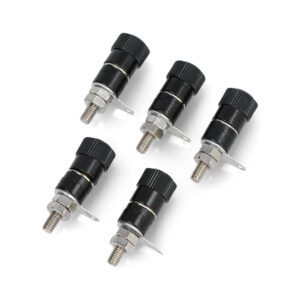Table of Contents:
In the world of electronics, where precision and reliability are essential, there is one unassuming component that plays a key role in creating solid, secure electrical connections – the banana connector.
While it may seem like a simple component, its importance in the design, prototyping and testing of devices cannot be overestimated.
Therefore, we decided to take a closer look at it.
Learn about its basic features, the variety of available types and the key applications of the banana connector.
A brief history of the banana connector
Origins of the banana connector date back to the early years of the 20th century, when it was first designed as a simple but effective solution for connecting cables to measuring devices.
Its invention is credited to two companies: Hirschmann and General Radio Company, but it was the former that patented the socket in 1929.
The name “banana connector” derives from its characteristic elongated shape, resembling a banana fruit.
Over the decades, the connection has undergone numerous modifications and improvements, becoming a standard in many electronic applications.
Construction and characteristics of the banana connector
Banana connector consists of a metal pin, which can be fully smooth or have transverse notches to increase the flexibility of the connection.
The standard diameter of the pin is 4 mm, which allows easy connection to sockets in measuring devices, mounting boards and other electronic accessories.
The popular connector usually comes with an insulated plastic housing, which protects the user from electrical shock and provides convenience of use.
There are also versions of banana connectors on the market with different diameters, colors and types of insulation to suit specific applications or working conditions.
Types of banana connectors
Although the basic function of banana connectors remains common to all types of plugs and sockets, the variety in design means that each type finds its own unique application.
Here are some of the most popular types that are worth knowing:
- Single banana connector – this is the most basic type of connector, accepting a single banana plug.
Found mainly in audio equipment, these connectors are standard in many simple electronic applications. - Double banana connector – allows you to connect two banana plugs at the same time, which is especially useful in advanced systems requiring complex connections.
- Panel banana connector – designed for installation in control panels, rack cabinets and other panel surfaces, comes with features for secure installation, such as nuts or retaining rings.
- Insulated banana connector – has an insulated housing to prevent accidental contact and ensure safe use.
- Angled banana connector – has an angled connector, which is useful in areas with limited space and allows for more ergonomic cable placement.
- Banana connector with surge protection – equipped with protection circuits against sudden surges, protect devices from potential damage.
- Banana connector with screw terminal – allows the cable to be attached without soldering, making it ideal for quick and temporary configurations.
The principle of the banana connector
Principle of operation banana connector is extremely simple, which contributes to its popularity.
When the pin is inserted into the connector socket, a mechanical and electrical connection is made.
The flexibility of the pin, often increased by notches, ensures good adhesion and contact with the socket, which minimizes the risk of a bad connection or break in the circuit.
Depending on the design of the connector, the connection can be further secured by spring or screw mechanisms, ensuring stability even under harsh operating conditions.
Advantages and limitations of banana connectors
Banana connectors are popular primarily because of their versatility and ease of use.
Their compatibility with a wide range of devices makes them a versatile solution for a variety of electronic applications, from simple hobbyist projects to complex systems in professional laboratories.
The simple design of banana sockets makes it possible to create connections quickly and seamlessly, eliminating the need for specialized tools.
In addition, many models of banana sockets incorporate insulation to improve user safety, minimizing the risk of electrocution.
The ability to choose from a variety of socket types allows designers and engineers to match components to specific project requirements.
Despite their many advantages, banana connectors also have some limitations that can affect their use in more demanding applications.
The conductive metal components in banana sockets are susceptible to corrosion, so replacement is necessary over time.
The physical durability of banana sockets can also be a challenge in environments where frequent plugging and unplugging is the norm, which can result in faster component wear.
Application of banana connectors
Finally, it is worth mentioning where it is used banana connectors.
These components are extremely versatile.
They are encountered in measuring devices such as multimeters, oscilloscopes or laboratory power supplies, allowing easy connection and disconnection of components when testing circuits.
In education, thanks to its simplicity and safety of use, the banana connector is ideal for learning and experimenting with electronics, allowing simple circuit building.
In addition, in the audio world, banana connectors are prized for their robust connections and excellent signal transmission quality, finding use in advanced audiophile systems.
How useful was this post?
Click on a star to rate it!
Average rating 0 / 5. Vote count: 0
No votes so far! Be the first to rate this post.




















